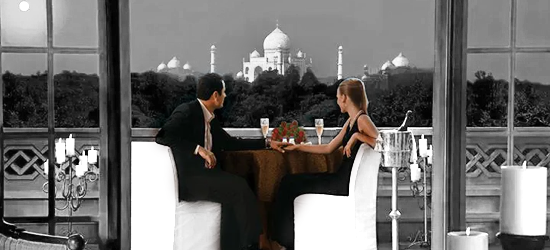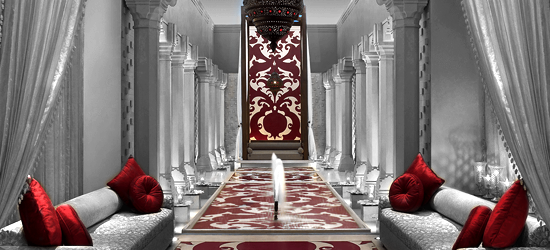
Welcome
Atithi
Alluring Agra
Travel Ideas
Go Beyond Luxury, Feel the Opulence

Welcome
Go Beyond Luxury, Feel the Opulence
If there is one iconic image that describes India, it would be the Taj Mahal, and that magnificent structure is located in the great city of Agra. Less than a half-day drive south from the capital of Delhi, Agra is one of the most popular destinations of all of India. The “modern” city of Agra, founded by Akbar in 1558, is associated with the Mughals. During its Golden Age, Agra was the foremost city of the Indian subcontinent and the capital of the Mughal Empire under emperors Babur, Humayun, Akbar, Jahangir, and Shah Jahan. Agra is also called “the city of love,” as it is the home of the symbol of one of the greatest love stories of medieval India, the Taj Mahal

Featured a best 50 hotels in the world, located just 600 metres from the Taj Mahal, the world’s most exquisite testimony to undying love, it is easy to rekindle romance at The Oberoi Amarvilas. The best hotel in Agra is inspired by Mughal palace designs; with fountains, terraced lawns, reflection pools and pavilions. The Oberoi Amarvilas is a luxury hotel in Agra that offers unrestricted views of Taj Mahal from all rooms and suites, complemented by our warm, personalised hospitality.

Sprawled over 23 acres of luxurious gardens, ITC Mughal, a Luxury Resort & Spa in Agra is a fitting tribute to the great Mughal builders of the past. The only Indian hotel to have won the prestigious Aga Khan Award for its excellent representation of Mughal architecture. In close proximity to the Taj Mahal, this luxury resort offers 233 opulent rooms and suites, a resplendent spa, signature cuisine offerings and a range of elaborate banqueting facilities. It recreates a paradise for the contemporary Mogul - exemplifying the splendor and perfection that was the hallmark of the Mughal Dynasty.
Agra is the city of the Taj Mahal, perhaps the most photographed monument in the world. Commissioned in 1632 by the Mughal emperor Shah Jahan, it houses the tomb of his beloved wife of three, Mumtaz Mahal, and himself as well. As one of Seven Wonders of the World, the Taj Mahal is regarded by many as the best example of Mughal architecture and is widely recognized as "the jewel of Muslim art in India." Verses of the Quran are inscribed in the marble with fine pietra dura inlay work, and ornate floral patterns incorporate semi-precious stones of translucent colors. The most elegant and largest dome of the Taj Mahal has a diameter of 60 feet, a height of 80 feet, and is one of the most recognized silhouettes in the world.
The Agra Fort is an astounding structure comprised of spacious palaces, royal residences, opulent harems, magnificent towers, impressive ramparts, and awe-inspiring gateways. This stately structure showcases not only the political stature and power of the Mughal Empire under Akbar but also the advancements made in the spheres of art and architecture. The present-day structure was built by the Mughals in 1565 to 1573, though a fort had stood there since at least the 11th century CE. One can easily spend an entire morning strolling the grounds amid the regal buildings and lush gardens.
Visitors should not miss I’timad-Ud-Daulah’s Tomb, also known as the Baby Taj. The tomb, built between 1622 and 1628, represents a transition between the first phases of monumental Mughal architecture. Often described as a jewel-box for its small size and fine detail, this mausoleum sits in a large garden setting that is crisscrossed with walkways and small waterways. Similar to the Taj Mahal, the marble walls of the Baby Taj are also encrusted with exquisite inlays of carnelian, jasper, lapis lazuli, onyx, and topaz in dazzling displays of floral patterns.
A few miles west of Agra, visitors will find Akbar's Tomb, the resting place of the Mughal emperor Akbar the Great. It was built in 1605–1613 by his son, Jahangir, and is situated on 119 acres of gardens. Visitors enter through the south gate, with its four white marble chhatri-topped minarets. The tomb building is a four-tiered pyramid, topped by a marble pavilion containing the false tomb, with the actual tomb located in the basement. Panels of deep red sandstone and white marble are decorated with inlaid panels of black slate.
Enjoy a stroll through the grounds of Fatehpur Sikri, a grand “Abandoned City” in the countryside 45 minutes west of Agra. The city was built by the great Mughal Emperor Akbar as his capital but, after a few years, the occupants fled due to a scarcity of water. The whole 145 acre city is built of red sandstone and remains in excellent condition today. The Imperial Palace complex consists of several independent pavilions arranged in formal geometry, a pattern derived from Arab and central Asian tent encampments.
Stop at nearby Bharatpur to enjoy a relaxed tour of Keoladeo Bird Sanctuary via cycle rickshaw. The park was formerly a waterfowl hunting reserve of the Rajput Maharajas of Bharatpur, but is now a managed wetland and one of the many national parks of India. The 29 square kilometer reserve is locally known as Ghana and is a mosaic of dry grasslands, woodlands, swamps, and wetlands. As one of the richest bird areas in the world, the park is visited by tens of thousands of migratory waterfowl each year for winter breeding. Many species migrate to India from Siberia, Afghanistan, China, Turkmenistan, and many other northern countries, and stop at Keoladeo on their journey south.
Mughal Garden: On the western bank of the River Yamuna, this lovely garden can be found in perfect alignment with the gardens of the Taj Mahal, which are situated across the water. Mehtab Bagh, which is 300 square metres in size, has been the location of a number of fascinating excavations. According to local legend, Babur, the Mughal emperor, constructed a sequence of 11 pleasure gardens along the riverfront, with this one being the final one. Today, it serves as a charming vantage point from which to observe and capture images of the Taj, a marble marvel. It is highly recommended that you take in the view from the front gate.
* Mughal Heritage Walk with Local village visit: Mughal Heritage Trail is a initiative offering a unique interactive experience of rare behind the scene glimpse of one of the world's most treasured tourist attraction TAJ. Experience walking through a historic settlement Kachhpura which depicts the life style of rural India. It is an experience of the traditions, culture of region with its people through the traditional welcome of guest, experience of the living style by providing a visit into a traditional house.
* Mohabbat e- Taj: Presents a series of play depicting the saga of love. The true and immortal love of Shajahan for Mumtaj Mahal- his beautiful wife; the lavish lifestyle of Mughal era; hardship of the artisans for 22 years that created the most precious specimen of craftsmanship. The effort to hold up the cultural and historical legacy of India is worth a glance to witness the Indian heritage come alive.
Tonga ride from hotel to Taj Mahal: It is, in fact, the most feasible and veritable source of fun mode of transport. Vivacious, amusing young men, who are more than willing to help. These Tonga wallahs will do their best in making you feel at ease. The horses of the Tonga are equally colorful and active. A Tonga ride in Agra is sheer fun and frolic all through. Most of the Tongas are covered and give you the feeling of being a royal guest.
High tea at Taj Khema: A tear drop on the face of eternity " is how Nobel Laureate & renowned Indian thinker, Rabindranath Tagore described the Taj Mahal. The mystic romanticism of the Taj and her timeless charm can be best experienced by spending an idyllic evening at Taj Khema, a series of verdant gardens perched on a hillock overlooking the Taj, while enjoying your cuppa.